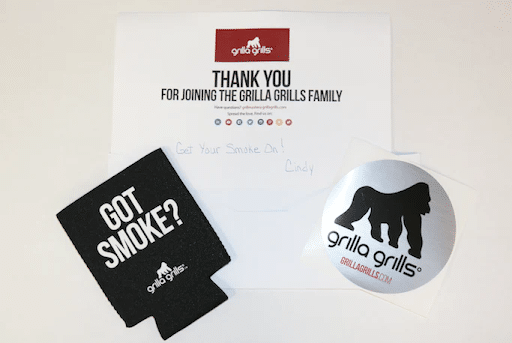So much of today’s marketing focus is on digital aspects, like tweaking SEO strategies and fine-tuning Amazon product descriptions. But sometimes, a human touch goes a long way. Amazon product inserts can feel like an old-school way of making contact, yet in reality, this strategy can take customer service to the next level and help your brand stand out from the crowd. From advertising new products to gauging customer satisfaction, investing in Amazon product inserts can do big things for your business.
Key takeaways
- Amazon product inserts can be a great way to keep customers engaged after making a purchase; benefits include promoting products, growing numbers of reviews, and building customer loyalty.
- Amazon has rules in place surrounding what sellers can and can’t do, so be sure to understand the policies around things like soliciting reviews and providing off-platform contact information before approving a final design.
- The success of Amazon inserts depends on business goals as well as the strategy behind creating a compelling product insert card; if a card isn’t designed with specific objectives in mind, you may not see the results you’re hoping for.
What are Amazon product inserts?
Have you ever ordered a product from Amazon and received a paper slip on the inside of the package, perhaps promoting a new product release, thanking you for your business, or offering a discount code for a future purchase? That’s an Amazon product insert: a way to communicate with customers via the product they ordered. These inserts can cover a wide array of information and offer a unique opportunity to connect with a buyer, adding what feels like a more personal touch to a standard online order.
Should I use Amazon product inserts?
Whether you should use Amazon product inserts will depend on your goals as a business and the messages you want to communicate to customers. In general, the pros far outweigh any cons—provided you’re following Amazon’s best practices. There are many benefits when Amazon product inserts are used properly, from promotion to customer loyalty.
Product promotion
Launching something new? Looking to discontinue a product and replace it with something else? Trying to boost flagging sales on less popular items in your Amazon storefront? An Amazon product insert targeting product promotion might be able to give you a big step up. A product insert card can be used to spread the word about product debuts and advertise promotions, including product descriptions, promo codes, and upcoming sale dates.
Get customer reviews
Getting customers to leave reviews can be harder than it sounds, particularly when there are minimal ways to stay connected with buyers after an Amazon marketplace order. However, product inserts can bridge the gap.
By providing a reminder on leaving reviews, you can remind customers of a step they may have otherwise forgotten in the excitement of receiving their package. Take note—Amazon has some strict rules surrounding prompting reviews, so make sure you understand them before drafting your insert.
Client care
If customers have questions, concerns, or comments to make about products or your company’s services, getting in touch may not be straightforward or intuitive. With an Amazon product insert, you can provide clear information about reaching out, including where to go to find FAQs, how to connect with you on Amazon, and where they can find supplementary information about your products, like video tutorials. Even if a customer isn’t satisfied with a purchase, knowing how to establish contact can go a long way in placating potential complaints.
Build customer loyalty
Customers want to feel as though they’re valued as individuals, not just for the revenue they provide for your company. Things like Amazon product inserts go the extra mile in doing this; little things like a “thank you” in an otherwise generic brown package can put a human touch on the anonymity of product delivery. Customers remember these kinds of things, and will associate the kindness and individuality offered by your brand.
In addition, you can use these kinds of inserts to actually reward loyalty by offering promos for future purchases, or suggesting other items that may go well with a current order.
Get more referrals
Many shoppers who use Amazon are looking for items first and brands second. They may not know the company they’re buying from or realize that the company has a robust offering of other products. As such, they’re unlikely to recommend your brand as a whole over your specific products.
However, an effective use of Amazon product inserts can introduce customers to who you are beyond your Amazon presence by including things like social media handles and product catalogs. This can help customers explore your brand, come back for more purchases, and talk about you to their friends. You may even be able to offer promos for first-time buyers, incentivizing buyers to pass your inserts on to their friends.
Examples of good product inserts
The potential benefits of using Amazon product inserts are obvious, but how to achieve your objectives can be less clear. These good product insert examples can help you guide your marketing campaigns in the right direction.
Teespring

As a company dedicated to custom end results, Teespring provides a simple and colorful guide to maximizing the use of their services. This strategy shows the merit of how instructions can complement a product. Just be aware of the product insert restrictions when doing something similar.
Grilla Grills

A producer of grills and smokers, Grilla Grills goes the extra mile by including a branded coozie, a sticker, and a handwritten note. This speaks to their line of products offering a coozie that can keep drinks cold while using their products.
The Sill

An eCommerce solution to buying plants, The Sill focuses on sustainable packaging that still keeps plants safe, and provides plenty of information for customers new to plant parenthood. With a cute yet comprehensive care guide specific to each product, customers can provide everything needed for new plants to thrive.
Read more: What are Amazon Add-on Items?
How do I add product inserts to my packaging?
There are two shipping options for those utilizing the Amazon marketplace: FBM (Fulfilled by Merchant) and FBA (Fulfilled by Amazon). In the first option, each business is in charge of packaging and sending goods upon purchase. Using FBA, on the other hand, Amazon handles the heavy lifting.
- If you’re using FBM, you’ll be the one to add product inserts yourself. You can choose what to add and what to exclude in real-time, giving you the chance to capitalize on things like inserts for a new product as soon as it hits shelves.
- However, if you’re using FBA, product inserts will need to be included with all items sent to the Amazon fulfillment centers. This means that once products are sitting in an Amazon center, waiting for purchasing and processing, adding inserts is out of your hands. Even if a promo is discontinued or a product is out of stock, the cards you provided with packaging will continue to be sent out.
When weighing insert options, it may be worthwhile to use more evergreen content, especially if you’re not handling your own fulfillment.
Amazon product insert policy
Amazon’s seller code of conduct is robust, which means businesses need to abide by their rules to successfully get inserts into customers’ hands. These policies don’t apply to inserts specifically but dictate how sellers are expected to act on the platform in general.
Product insert policies you should pay attention to include:
- Review rules: Trying to influence reviews, manipulate customers into giving reviews, encouraging only positive reviews, or rewarding customers for leaving reviews is strictly prohibited. Amazon takes the legitimacy of its reviews system very seriously and requires that any review prompting is done in a neutral manner, so attempts to push positive reviews can result in big problems for sellers.
- Communication rules: Amazon frowns on any communication off-platform and asks that all contacts go through the Buyer-Seller Marketplace where orders are concerned.
- Off-platform sales rules: Amazon prohibits directing customers to other marketplaces or shopper sites to make purchases for products discovered through Amazon’s platform.
Amazon takes violations of its rules seriously, and once a violation is noticed, there may be little opportunity for recourse. Failing to follow the code of conduct can result in the termination of product listings, forfeiting payments, the closure of a seller account, and even legal action. When in doubt, double-check Amazon’s policies before moving forward with a potentially problematic product insert card design.
Note that these rules don’t differ based on fulfillment. If you’re using FBM and doing your own packaging and shipping, you’re still required to abide by Amazon’s seller policies.
Best practices for Amazon product inserts
Amazon product inserts can do a lot of good for burgeoning brands. However, to achieve the potential upsides, you can’t throw any old card into a shipping box and call it a day. As a rule of thumb, ensure you say thank you for every order. A simple “thanks for your purchase!” on your Amazon product insert can go a long way. Beyond this, keep these other best practices in mind when designing your inserts.
Have a strategy in place
Know what you want to achieve with your inserts, and customize the design based on this objective. It’s fine to have multiple business priorities associated with the use of Amazon product inserts, but trying to do everything at once likeasking for reviews, advertising new products, announcing promotions, and offering referral bonuses simultaneously can mean a muddy, busy design that won’t resonate with customers.
Be creative
Regular Amazon shoppers see a lot of product insert cards, so you want to do what you can to make yours pop. The more personalized and creative your insert looks, the more likely you are to stand out from other sellers.
Use different cards for different purposes
A format or appearance that worked for one product may not work for a different marketing goal. Design new cards for each objective, making sure the intention is always clear. While too many cards can confuse your priorities, more than one card per package can be an option when there are multiple points you’d like to make.
Reward customers whenever possible
It might not always be in the budget to offer customers promos, but when you can, consider doing so. This is especially true for products that have a temporary use and will need to be replaced eventually; if customers liked your product a discount will go a long way to generating another purchase.
If appropriate for your products, adding samples or gifts can be a great way to go above and beyond. Things like an extra battery for a device, a hand-beaded bracelet for a jewelry purchase, or a branded extra, like a pen or sticker, can keep your company front of mind.
What to avoid with Amazon product inserts
As with best practices, there are things to actively avoid when designing your Amazon product inserts.
- DON’T go against any of the seller policies outlined above. Even if this seems like a good way to get around some of the more restrictive rules as a seller, it’s not worth doing so. The last thing you want is to harm your business in the process of boosting marketing efforts.
- DON’T say anything negative, including about similar products or other sellers. It’s fine to talk up what makes you unique, but this shouldn’t be at the expense of denigrating another business.
- DON’T make your insert too complicated. These cards should be easy to read, so throwing everything about your brand onto a single card is a good way to overwhelm buyers or drown out your message.
- A QR code can be a good way to streamline things, guiding customers to a landing page with all of the product information and rewards details you have available. This way, your cards can stay clean and organized without neglecting anything important.
How do I design a product insert?
A nice-looking Amazon product insert is a must, but that can be a daunting proposition for companies, especially when budgets are tight. Luckily, this doesn’t have to be an expensive process. While hiring a designer is always an option, it’s not the only road available to you. There are plenty of free and low-cost programs that can help you design a polished, professional product.
Canva is a great option for designing product insert cards. The platform is available for free for the basics, with the premium options unlocked for a low annual fee. User-friendly and stocked with tons of pre-made card templates, getting started is simple. You can also work from basic templates on photo sites like Shutterstock to build your branding cards from the ground up. There are also other free or low-cost design platforms to consider, like Desygner and Adobe Express, as well as more professional tools, like Photoshop.
When creating your card, be sure to focus on:
- Your brand. You want the color scheme and font choices to align with your logo or, alternatively, the product you’re promoting.
- Your target strategy. If you’re focusing on a new product launch, put a picture front and center. If you’re providing a discount code, make sure it’s very obvious. If you’re after reviews, put instructions on the front of the card, not buried in company info on the back.
- Legibility. Ensure the card is clear and easy to read. As noted, a QR code leading to a landing page can be a great way to organize information that won’t fit on a card.
- Must-have content. It would be nice to tell customers everything about your brand, but reserve that for your product listing and limit content to what’s essential to make your objectives clear. If you’re focused on a promo code, your product insert card probably doesn’t need founder names or company history.
Once you have your design solidified, you can either print your cards yourself, should you have the kind of printer that handles cardstock, or use a POD service like Vistaprint to order the selection of cards required.
Do product inserts work?
In short, yes, Amazon product inserts do work. However, as with everything in marketing, how well they work will depend on the approach your business takes, the caliber of the inserts, and their intended purpose. For example, an insert intended to advertise products but lacks an engaging design may not convert as well as you’d hoped. But as long as your inserts are designed with strategy in mind, a simple slip in an Amazon box can do wonders.
At Trellis, our managed services, in tandem with our software, can help Amazon sellers with everything from their product launch strategies to pricing to advertising. Leveraging both can help you uncover what strategies might work best for your Amazon product inserts, including promos and discounts to help improve your revenue. Contact us today to learn more about how we can support your Amazon seller objectives.














